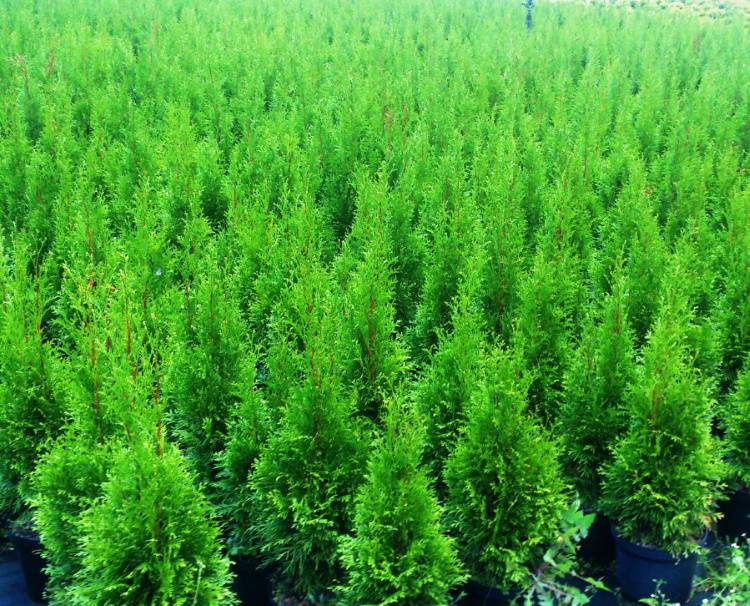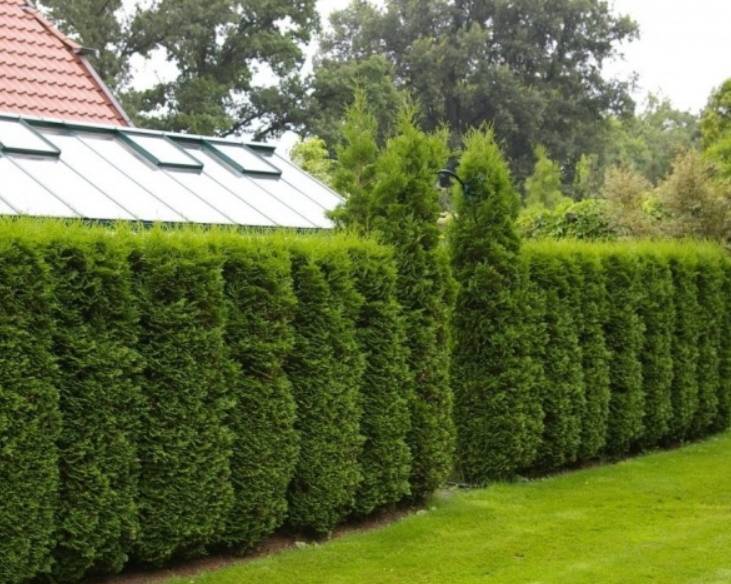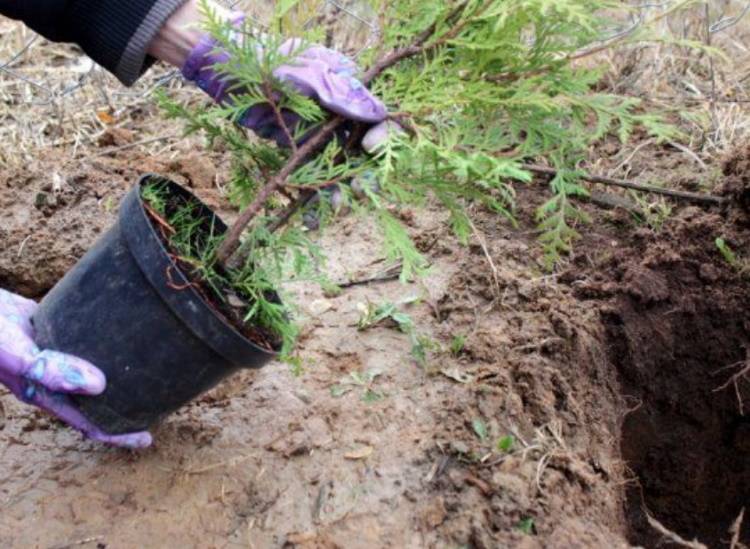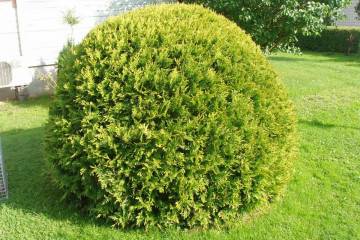Thuja columnar western - description of varieties
Content:
Tui - low conifers from the cypress family, they are often used to decorate personal plots, city parks, squares. Artificially bred ornamental tree species are propagated in nurseries in many countries. Tui are very unpretentious, have high cold resistance, live long. The plant has many garden forms - the crowns of various varieties of thuja can be conical, columnar, pyramidal, spherical, pin-shaped, umbrella-shaped.
Thuja columnar western
The tree has the Latin name Thuja occidentalis. In the homeland of the plant, in North America, it is known as the "Tree of Life". It can grow on any soil, it takes root easily. Thuja needles, when touched, emit a spicy aroma, retain their color all year round, are painted in green, blue, yellowish shades, and can be variegated. In Russia, thujas are called northern cypresses.
In Europe, thuja western columnar evergreen, used to form hedges and various compositions, has gained particular popularity. The plant is bred in the form of compact shrubs and trees. Thuja occidentalis have horizontal shoots tightly adhering to the trunks, crowns up to 1.5 m wide. Needles, consisting of small scales, grow on the branches, which gradually renews over 2-3 years.
For most thujas, slow growth is characteristic - in artificial conditions, plants grow on average up to 10 m. Old trees are covered with fibrous gray-brown bark, there is no resin on it, but there are many cracks. The life cycle of plants can last up to 200 years. The development of trees is not affected by the gas pollution of the city atmosphere, dust, smoke. Haircuts, trimming, transplants are not scary for them, some species are not afraid of frost and do not need shelter even at an air temperature of -36 ° C.
Types and varieties of columnar thuja
Planted in a flower garden, on an alpine hill, the columnar thuja will become a background for other plants, in different-height plantings it will act as a vertical decoration. From various varieties of Thuja occidentalis, such as Smaragd, Wagner, hedges are created.
Specialists create landscape compositions from all varieties of columnar tui. Plant crowns can have the most bizarre shapes. Evergreens with high decorative characteristics include:
- Variety Brabant (Thuja occidentalis "Brabant") is a fast-growing tree with bright green needles with golden tips, which can have a 4-meter crown diameter and 20 m in height, with an increase in height of 40 cm per year.
- Variety Yellow Ribbon (Thuja occidentalis "Yellow Ribbon") - even at the age of 15 years, the plants do not grow higher than 2 m. They differ in that young shoots have a yellow-orange shade of needles, which, in cold weather, first changes its color to light green , then to the bronze color.
- Columna variety (Thuja occidentalis "Columna") - used for group plantings. By the age of 10 it grows up to 3.5 m in height. Trees of this variety have a very dense, narrow crown. In the cold, the needles change their bright green color to brownish.
- Variety Smaragd (Thuja occidentalis "Smaragd") - trees are suitable for single cultivation. They grow rather slowly, the annual growth is no more than 25 cm, used for low hedges and growing in containers. May have spiral-curved trunks.
- Variety Aurea Pyramidalis (Thuja occidentalis "Aurea Piramidalis") - the species is most often a short shrub with a golden yellow color of needles, although there is also a yellow columnar thuja Aurea Pyramidalis up to 6 m high, which does not change the color of fan-shaped shoots on cold days. Both varietal species are actively used in multi-colored designer living compositions.
- Variety Holmstrup (Thuja occidentalis "Holmstrup") - the crown of this type of tree does not have to be cut often, because shoots with green needles grow very slowly. It has a superficial root system, therefore it needs fertile soil, watering and fertilizing.
The parks will always be decorated with two types of columnar folded thujas - golden yellow Aurescens (Thuja plicata "Aurescens") and dark green Excelsa (Thuja plicata "Excelsa"). They are rapidly gaining popularity in Europe, they are grown for the arrangement of high hedges, for nesting and paired plantings.
Planting columnar thuja
Warm April days, when the threat of return frosts has passed, and early autumn are best suited for planting one-year and two-year-old thujas. Young seedlings are chosen, grown in individual plastic containers filled with fertile soil. Planting of plants is done by the method of transshipment with a closed root system: the tree is carefully twisted out of the pot along with a lump of earth.
If the plant has an open root system, a fallen clod of earth, then it is impossible to delay the transplant. The roots should be wrapped in wet burlap and the fabric will have to be constantly moistened.
The place for planting plants should be protected from drafts, depending on the variety of thuja, the degree of illumination of the site is chosen.
For plants, a hole is dug 3-4 days before planting, its depth and volume depend on the size of the plant roots - they should sit freely in the recess without bends. Tuyam does not need waterlogged soil, if groundwater runs close to the soil surface, a layer of drainage material 15-20 cm thick is poured onto the bottom of the planting pit.
To fill the pit, a soil mixture is prepared from the pit soil - 2 parts, 1 part each of peat and 2-3 year old humus, add 30-100 g of superphosphate. At the bottom of the pit, a layer of fallen leaves, leafy earth is poured over the drainage, then a slide is made from part of the prepared soil mixture. The central part of the root system of a seedling or tree is installed on it. The roots of the plant are placed on the slopes of the hill, covered with soil mixture, so that the root collar remains above the soil level. Then the seedling is watered.
The main condition for good survival of trees and seedlings of thuja columnar will be the correct planting and care of plants during this period.
Thuja care after planting and during cultivation
Transplanted plants need regular watering. In cool weather, watering is carried out 1 time in 7-10 days, in heat 2 times a week, while the young trees are moistened with a spray bottle. The volume of water depends on the size of the plant. Wet soil in the root zone is mulched. Fallen leaves, sand, sawdust are used as mulch.
Plants, which have been growing in one place at home for many years, need not only regular watering (in the heat, not less than a bucket 2-3 times a month), but also fertile soil. They use organic and mineral fertilizers. In the spring, nitrogen-phosphorus dressings are carried out, in the summer, nitrogen-potassium, in the fall, phosphorus-potassium. Use 1 tbsp. each substance per 10 liters of water.
The preparation of plants for wintering depends on their varietal characteristics and the age of the plants. Without fail, shelters made of agrofibre are constructed for young immature plants.
Reproduction of columnar thuja
Decorative thuja are rarely propagated by seeds - it may take several years to grow a full-fledged seedling. A common and affordable breeding option is the grafting of strong shoots and the use of twigs with a part of the bark separated from the central stem in the form of a heel.
Planting material for rooting is planted in individual containers with a moist peat-leaf mixture, covered with a transparent cap, regularly ventilated and moistened the soil. Rooting occurred if new shoots appeared.
Causes of yellowing of columnar thuja
The yellowing of the needles occurs due to natural reasons associated with the change in the coniferous cover. Some varieties of thuja change the color of the needles during the onset of cold weather. The reason for the yellowing of trees can be mistakes made when planting plants and choosing a place to grow a plant, improper care, diseases and pests.
Tui are very decorative plants, many gardeners want to have them on their plots, but sometimes there is no time and there is no one to take care of them. Most often this happens in early spring, autumn, winter. In this case, no plants need to be planted. Despite their original beauty, trees may turn yellow, their crown may become thinner, needles fall off. Let the thuja always be well-groomed trees so that you can only admire them.




















